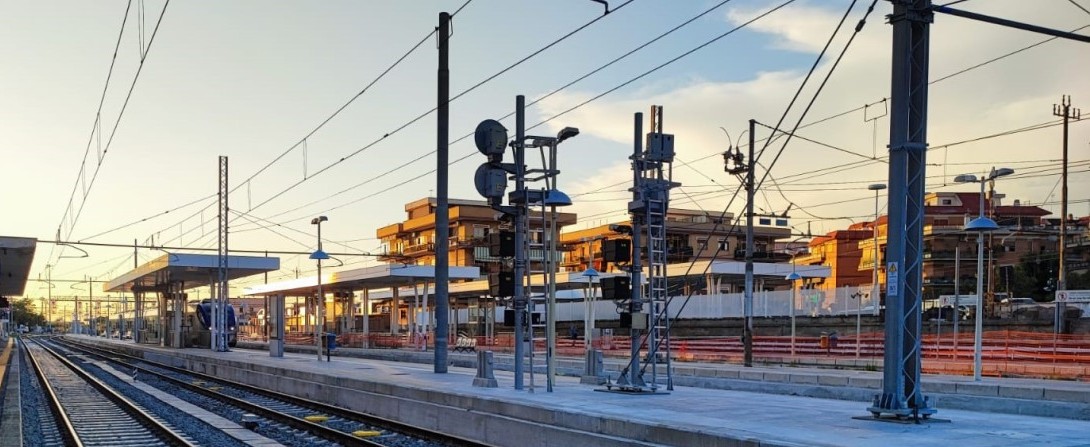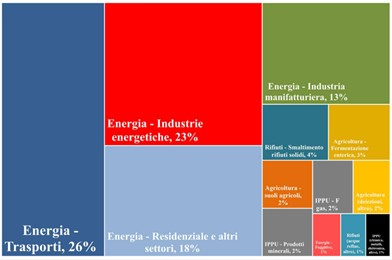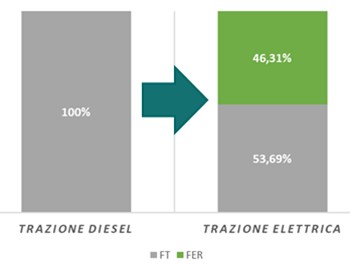Technology and sustainability
Electrification of Italian railway lines for low-emission transport

In a global context of increasing attention to decarbonization, the electrification of railway lines represents one of the most effective methods for reducing transport sector emissions, for encouraging the use of renewable energy, and for contributing to energy transition and sustainable development goals (SDGs). Italferr is a key player in numerous infrastructure interventions that aim to make the Italian railway system more modern, safe and sustainable.
The Italian emission context
According to the ISPRA 2024 Report, which refers to the year 2022, total greenhouse gas emissions in Italy amount to about 391.8 million tons of CO₂equivalent. Of these, the main contributor appears to be the transport sector, which accounts for about 26 percent of emissions. Despite an overall reduction of 20.9 percent since 1991, the transport sector remains among the most difficult to decarbonize, partly due to infrastructure deficiencies and sociocultural resistance to change.

National emissions of climate-changing gases in 2022 by sectoral categories (estimated proportion based on contribution in CO2 equivalent) - source: "Greenhouse gas emissions in Italy. Reduction targets by 2030," Ispra Report 399/2024
Electrification as a tool for transition
Electrification of existing rail lines is a key driver for more efficient and low greenhouse gas-emitting public transportation. It not only reduces fossil fuel use and related emissions but also increases the reliability and quality of rail service. These actions are in line with the goals of the European Green Deal and of the Integrated National Energy and Climate Plan (NECP).
The Jonica Sud Electrification Project[1]
Among the most significant projects Italferr is active in is the completion of the electrification of the Dorsale Jonica route that starts from the metropolitan city of Reggio Calabria (Melito P.S.) and, along the eastern coast of the region, reaches the city of Catanzaro (Catanzaro Lido) with an extension of almost 150 km. This intervention is part of a much broader infrastructural development context (Lamezia - Catanzaro - Dorsale Jonica) that envisages interventions aimed at improving the reliability of the railway infrastructure, increasing the speed at crossing locations, making the service more accessible, as well as the elimination of some level crossings with the aim of reducing interference with road traffic. As a result, it turns out to be not only relevant from an infrastructural point of view but also represents an important economic and social development opportunity for Southern Italy.
Assessment of greenhouse gas emissions associated with electrification works
Climate impact is strongly influenced by the spatial context and the specifics of the electrification project, which can have different levels of complexity when it is also associated with other interventions on the line. However, it is possible to estimate average baseline emission data that allow to define a reliable framework for the main elements required for electrification of an existing railway line:
- Electrical substations: about 10,000-40,000 tCO₂e per substation, considering civil works (excavation, reinforced concrete structures, hydraulic works, etc.) and also estimating the contributions of the main electrical components.
- Overhead line and supporting structures: about 80-100 tCO₂e per kilometer of electrified line, due to poles and portals, brackets, foundations, cables and components.
- Access roads and yards: about 5,000 tCO₂e/km, for access roads to service areas related to substations and other technological facilities.
These values are based on industry literature and on the experience developed by Italferr through years of sustainability studies and application of the Methodology for Calculating the Carbon Footprint of Infrastructure Projects, developed to obtain assessments in accordance with ISO 14064. It is important here to point out that, in infrastructure projects, most of the emission impact comes from civil works, while purely technological works, typical of electrifications of existing lines, are of marginal relevance in the emission context of infrastructure design and construction.
Assessment of emissions associated with the operation of the work
The main environmental benefit of electrification interventions is related to the reduction in emission of pollutants and greenhouse gases resulting from the transition from diesel to electric trains. The assessments were developed considering the specific characteristics of the rail line and rolling stock analyzed, following the methodologies indicated by the most authoritative industry guidelines.
GHG emissions are analyzed through Well-to-Wheel (WTW) analysis by comparing different rail traction solutions and their respective energy supply chains. Thus, emissions released directly to the atmosphere (TTW - Tank-to-Wheel) as well as those related to fuel production and transportation processes (WTT - Well-to-Tank) are quantified. Of these, WTT emissions are the only ones characteristic of electric trains.
Electrification of the Jonica Sud line, thanks to the change of power supply from diesel to electric and considering the entire economic life of the intervention, will allow a reduction in greenhouse gas emissions by about 40 percent compared to the current scenario.
Unlike climate-changing emissions, pollutant emissions have a direct impact on the local environment. Due to the electrification of the route, resulting in the replacement of diesel trains, the local emission of pollutants into the atmosphere is cancelled.
Recyclability and circularity of materials
Electrification interventions have an additional advantage in terms of sustainability: the materials mainly used, such as steel and copper, are highly and easily recyclable and, in many cases, already contain significant percentages of secondary raw material. This promotes a more circular approach to rail infrastructure and helps reduce environmental impact throughout the entire life cycle of the work, consistent with the principles of Life Cycle Thinking.
Contribution to SDG targets and Energy Transition
The electrification of lines contributes directly to the achievement of several Sustainable Development Goals (SDGs), including:
- SDG 9: Build resilient infrastructure and promote innovation;
- SDG 11: Make cities and human settlements inclusive, safe, durable and sustainable;
- SDG 13: Take urgent measures to combat climate change.
Furthermoew, the energy supply of the electrified railway infrastructure is characterized by a significant use of Renewable Energy Sources (RES), which, considering the current national energy mix, amounts to 46 percent.
[1] The Catanzaro-Roccella Electrification Intervention (Lot 4), including the Catanzaro-Melito Section, is currently being updated/revised following requests for clarification from the CSLLPP (so, compared to what is planned to date, it may be subject to updates). Moreover, an additional important aspect is that the intervention is currently in the process of acquiring only Lot 4 (Catanzaro-Roccella section), but not yet acquired, while Lot 5 (Roccella-Melito P.S.) is not in the process of acquiring funding.

Mix of energy supplies in the case of diesel and electric power supply
These results fit perfectly within the context outlined by Italy's Integrated National Energy and Climate Plan (NECP), whose targets show an increasing trend of supply from RES by 2030 for the transportation sector (equal to 34.2 percent) and for the electricity sector (equal to 63.4 percent).

Consequently, achieving the power sector goals would mean that rail line electrification projects would inherently bring an additional significant benefit in achieving the decarbonization goals related to the transportation sector.
Finally, reducing dependence on fossil fuels in rail transportation strengthens national energy security by providing a mobility system that is less exposed to fluctuations in international energy markets.
Conclusions
Electrification of railway lines is one of the most effective strategies for decarbonizing the transport system, improving service quality and promoting more sustainable mobility. Ongoing projects, such as the Jonica Sud Electrification project, are proof of Italferr's key role in driving the ecological and energy transition through a technical, integrated and environmentally conscious approach. Thanks to the use of recyclable materials, the adoption of advanced design standards, and the rigorous and consistent assessment of emissions, rail electrification is emerging as a pillar of the country's infrastructure sustainability.
[1] The Catanzaro-Roccella Electrification Intervention (Lot 4), including the Catanzaro-Melito Section, is currently being updated/revised following requests for clarification from the CSLLPP (so, compared to what is planned to date, it may be subject to updates). Moreover, an additional important aspect is that the intervention is currently in the process of acquiring only Lot 4 (Catanzaro-Roccella section), but not yet acquired, while Lot 5 (Roccella-Melito P.S.) is not in the process of acquiring funding.
Edited by Italferr, Sustainability Unit, and Environmental and Energy Saving Unit